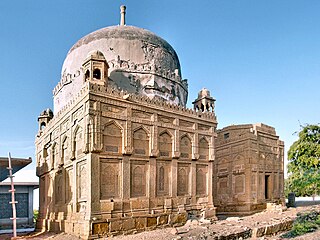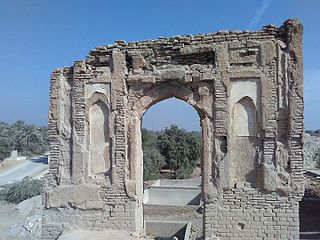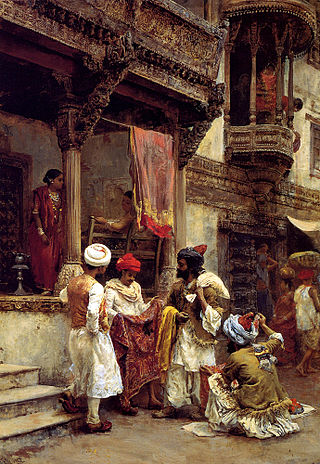Related Research Articles

Sindh is a province of Pakistan. Located in the southeastern region of the country, Sindh is the third-largest province of Pakistan by land area and the second-largest province by population after Punjab. It is bordered by the Pakistani provinces of Balochistan to the west and north-west and Punjab to the north. It shares an International border with the Indian states of Gujarat and Rajasthan to the east; it is also bounded by the Arabian Sea to the south. Sindh's landscape consists mostly of alluvial plains flanking the Indus River, the Thar Desert of Sindh in the eastern portion of the province along the international border with India, and the Kirthar Mountains in the western portion of the province.

Bahawalpur is a city in the Punjab province of Pakistan. It is one of the ten largest cities of Pakistan and 6th most populous city of Punjab. Bahawalpur is the capital of Bahawalpur Division.

Mirpur Khas is a village in Sindh province, Pakistan.. The city was built by Talpur rulers of Mankani branch. According to the 2017 Census of Pakistan, its population is 205913. Mirpur Khas is known for its mango cultivation, with hundreds of varieties of the fruit produced each year - it is also called the “City of Mangoes,” and has been home to an annual mango festival since 1955. After the completion of Hyderabad-Mirpurkhas dual carriage way, the city has become hub of commercial activities.

Bahawalpur District is a district of Punjab, Pakistan, with capital the city of Bahawalpur. According to the 1998 Census it had a population of 2,433,091, of which 27.01% were urban. Bahawalpur district covers 24,830 km2. Approximately two-thirds of the district (16,000 km2) is covered by the Cholistan Desert, which extends into the Thar Desert of India. The district is a major producer of cotton.
Longcloth refers to a plain cotton cloth originally made in comparatively long pieces.
The Samma dynasty was a medieval Sindhi dynasty which ruled the Sindh Sultanate from 1351 before being replaced by the Arghun dynasty in 1524.
Rahon is a city and a municipal council in the district Shaheed Bhagat Singh Nagar of the Indian state of Punjab. Rahon is in Doaba region of Punjab. Doaba also known as Bist Doab, is the region of Punjab, India that lies between the Beas River and the Sutlej River. A famous battle was fought here between Sikhs and Mughals i.e Battle of Rahon (1710).
Sindhi Lungi or Lungee are a hand-woven gold embroidered cloth worn by Sindhi men on ceremonious occasions like weddings, Engagements, Cultural day and events etc. The Sindhi Lungis are traditionally used as a scarf/shawl, turban and as sash/cummerbund.

Aror or Alor or Arorkot is the medieval name of the city of Rohri. Aror once served as the capital of Sindh.
Pakistani clothing refers to the ethnic clothing that is typically worn by people in the country of Pakistan and by Pakistanis. Pakistani clothes express the culture of Pakistan, the demographics of Pakistan, and cultures from Punjab, Sindh, Balochistan, Khyber Pakhtunkhwa, Gilgit-Baltistan, and Kashmir regions of the country. The clothing in each region and culture of Pakistan reflect weather conditions, way of living, the textiles and embroidery used and its distinctive style which gives it a unique identity among all cultures.

Shalwar kameez is a traditional combination dress worn by men and women in South Asia, and Central Asia.
Salwar or Shalwar is cloth worn from the waist to the ankles, covering both legs separately. It is the lower-garment of the Shalwar kameez suit which is widely-worn in South Asia. It is known for its lively hues, rich fabrics, and embroidery. It is also the national dress of Pakistan, and since the later 1960s with the salwar being used in government offices in Pakistan. The outfit has been a part of Punjabi tradition for centuries. Salwar can be distinguished from the Punjabi suthan which is shorter than the salwar.

The Ambala–Attari line is a railway line connecting Ambala Cantonment in the Indian state of Haryana and Attari in Punjab. The line is under the administrative jurisdiction of Northern Railway.

In the ancient Punjab region, people wore cotton clothing. Both men and women wore knee-length tops. A scarf was worn over the tops which would be draped over the left shoulder and under the right. A large sheet would be further draped over one shoulder which would hang loose towards the knees. Both male and female wore a dhoti around the waist. Modern Punjabi dress has retained this outfit but over its long history has added other forms of dress.

Sindhi clothing are a part of the Sindhi culture. Sindhi women and men wear the Shalwar Qameez or the Kurta with Pyjama. Women also wear Sari or ghagra. However, before the adoption of the Shalwar kameez, kurta, the Sari as well as other articles of clothing, Sindhis had their own traditional costumes.

There are two types of Saraiki shalwar suits which originate in the southern area of Punjab, Pakistan. These are the Bahawalpuri shalwar suit and the Multani shalwar suit. The two main suits from that area.

Khes is a thin cotton blanket cloth in the Indian subcontinent; it is a damask cloth used for blankets and winter wraps. Khes is generally hand-woven with coarse cotton yarns. Khes as a garment is a simple clothing item to wear loosely to cover the upper body by men in Pakistan and northwest India. Khes is an important cloth in the Sindh and Punjab, regions which are famous for its production and historically has been known for not only the production of Khes but also many other coarse cotton textiles, especially in the 19th and 20th centuries. Khes is a comfort object used in bedding, and is also usable as a cover.

Sussi or susi is a term for multicolored striped or checked cloth produced mainly in Sindh. Sussi is thin handloom fabric made of cotton, silk, or a blend of the two, with colored warp stripes. Sindh region was known for its production and exports during the Mughal period. Sussi was most often made with red and blue, blue and white, or green and white stripes, but other patterns were also produced. The fabric was exported to England, where sousaes were in great demand in the 18th century.

Mashru is a woven cloth that is a blend of silk and cotton. It was historically a hand-woven satin silk fabric variety found in the Indian subcontinent, and its proper use is described in the 16th-century Ain-i-Akbari.
The crafts of Sindh and its craftsmen are held in high esteem and their works are notable not only in Sindh but also in many other places.
References
- ↑ Watt, George (1904). Indian Art at Delhi, 1903: Being the Official Catalogue of the Delhi Exhibition, 1902-1903. J. Murray. p. 363.
- ↑ Duarte, Adrian (1982). The Crafts and Textiles of Sind and Baluchistan. Institute of Sindhology, University of Sind.
- ↑ Latifi, A. (1911). The industrial Punjab: : a survey of facts, conditions and possibilities. Longmans, Green, London. p. 39.
- ↑ The Gazetteer of West Pakistan: The Former Province of Sind Including Khairpur State. Gazetteer Cell, Board of Revenue. 1968. p. 288.
- ↑ Soomro, Faiz Mohammad (1977). Cultural History of Sind. National Book Foundation. pp. 77, 90.


